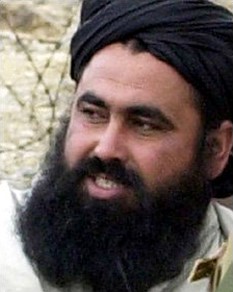Andrew McGregor
August 6, 2009
As Pakistani F-16 fighters attack Taliban targets in South Waziristan, the government and military leadership appear to be reconsidering their earlier attempts to persuade other Taliban commanders in the region to remain on the sidelines during a much-delayed ground campaign against Baitullah Mahsud, leader of the Tehrik-e-Taliban Pakistan (TTP).
The government’s appeals were directed principally at Siraj Haqqani, leader of the deadly Haqqani Network and son of renowned Afghan mujahideen leader Jallaludin Haqanni, Deobandi warlord Hafiz Gul Bahadur of the Uthmanzai Wazir (see Terrorism Monitor, April 10), and Ahmadzai tribal leader Maulvi Nazir, whose complex loyalties are somewhat difficult to grasp, being simultaneously pro-Bin Laden, anti-Baitullah Mahsud and pro-Pakistan when suitable (see Terrorism Monitor, May 14, 2007). Pakistan’s press has reported a series of meetings between government officials and TTP leaders designed to isolate Baitullah, as well as warnings issued to Taliban factions not to interfere with military convoys on their way to Waziristan once the planned offensive begins.
Bahadur and Nazir overcame their differences with Baitulllah in February, when they joined Baitullah in the Shura Ittihad-ul-Mujahideen (Council for United Holy Warriors) at the urging of Afghanistan’s Mullah Omar (The News [Islamabad], February 23). Little has been heard of this alliance since, suggesting this was only a temporary display of unity. Maulvi Nazir is a bitter rival of Baitullah. His participation in the new alliance was likely only a sign of his loyalty to Mullah Omar and there are conflicting reports on whether he will support or oppose Baitullah once the campaign begins.
A July 28 suicide attack by Bahadur’s faction against government security forces killed two members of the Frontier Corps and wounded five others, suggesting Bahadur has rejected the government’s advances (The News, July 29; Geo News, July 28). With Siraj Haqqani likely to side with Baitullah to protect his cross-border network, Islamabad appears to have realized the isolation of Baitullah within the Pakistani Taliban is unlikely. After having served as their sponsor for several years, Baitullah is likely to be joined in any conflict against government forces by the remnants of the Islamic Movement of Uzbekistan (IMU), which has been based in Waziristan since being expelled from Afghanistan in late 2001. Known a decade ago for their skills in mountain warfare, the present capability and strength of the Uzbeks is uncertain after years of attrition and isolation from Uzbekistan, but Baitullah’s fall will surely result in their destruction, giving the remaining Uzbeks a strong incentive to repel any government incursion.
While there have been numerous unconfirmed reports of negotiations between the government and Baitullah, a senior Pakistani military official told an Islamabad daily that it was now too late for talks: “Both the civil and military authorities have concluded that Baitullah is an enemy of Pakistan and must be dealt with accordingly” (The News, August 3).
While the major Taliban leaders appear to be lining up behind Baitullah, a number of lesser commanders appear prepared to seek retribution from Baitullah for various past offenses. A former ally of Baitullah, Turkistan Bhittani, has already started operations against Baitullah’s men in the Tank region after having declared his readiness to take on Baitullah’s men as soon as Islamabad gave the green light (ANI, July 13; AFP, July 11). Bhittani has joined with two other factions in the reformed Abdullah Mahsud group (named for the late Mahsudi Taliban leader). Local press reported the new Amir of the alliance, Waziristan Baba (a.k.a. Ikhlas Khan) had sworn revenge on Baitullah for killing people in South Waziristan and destroying schools and hospitals (The Nation [Islamabad], July 23). A later statement from existing Abdullah Mahsud commander Qari Misbahuddin Mahsud denied the appointment of Waziristan Baba, claiming he had been sent by Baitullah to create rifts amongst the Abdullah Mahsud Taliban. According to Qari Misbahuddin, Waziristan Baba had already been expelled after less than two months in the Abdullah Mahsud group. A decision had been made to kill him, but he escaped before it could be implemented (The News, July 24).
The Pakistani military is still in the process of consolidating its control of Swat, Buner and Dir. Militants driven out of these areas are reported to be regrouping in Shangla District. For the moment, Baitullah’s ability to operate beyond South Waziristan appears to be restricted, giving the government time to pursue its aerial campaign (using American supplied targeting intelligence) against him while avoiding a wide-scale conflict against a combination of Taliban factions in Waziristan. Aerial operations, however, are incapable of establishing the government’s writ across the Tribal Agencies of northwest Pakistan. Pakistan’s F-16s cannot carry out night operations, leaving the battlefield to the Taliban at night. As American and international pressure builds for a ground assault on South Waziristan, Islamabad will use the bombing campaign to buy enough time to find alternatives, whether through the submission of Baitullah Mahsud, or the creation of a tribal alliance capable of ensuring victory in a land campaign.
A senior Pakistani security official explained the government’s decision to act against all of South Waziristan’s Taliban warlords rather than attempt to isolate Baitullah. “We have delayed the operation only to broaden its horizon. The militants in the border regions have developed joint networks, therefore it is imperative to confront them on both sides of the border so that they do not slip from one area [to] another during the course of operations… It would be difficult to confront Baitullah Mahsud and leave the other ones alone. The operation would have to be an all-out war against all of them” (Adnkronos International, July 31).
This article first appeared in the August 6, 2009 issue of the Jamestown Foundation’s Terrorism Monitor

